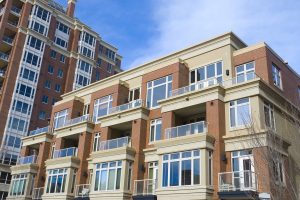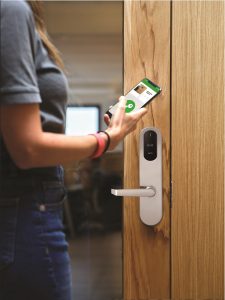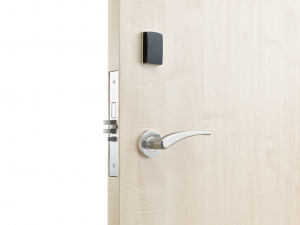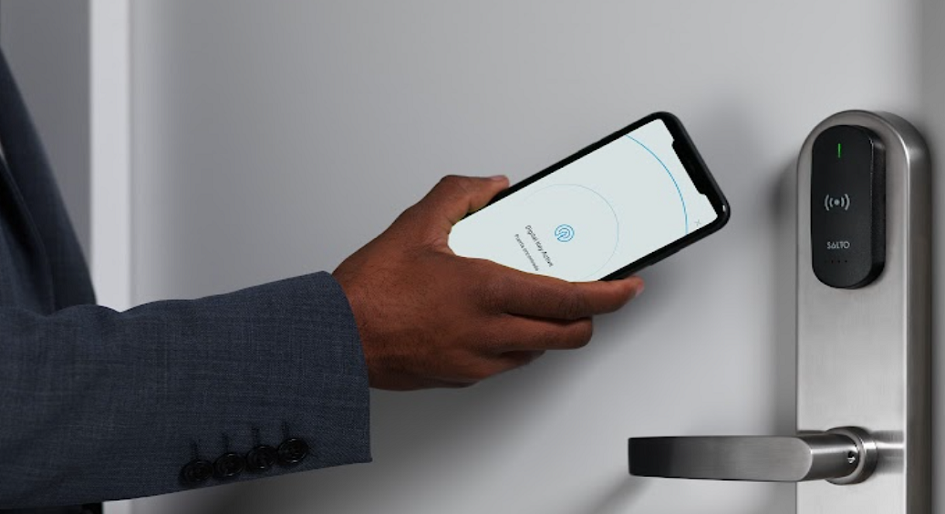The work-from-home revolution, rise of online deliveries, and other resident trends have created a buzz at multifamily buildings. With this increased activity comes heightened considerations for building security and access control that property operators are wise to address.
Ahead, Preston Grutzmacher, Residential Business Leader with SALTO Systems, shares insights into multi-residential access control trends and technologies.
How has the pandemic and work-from-home shift increased the need for “smarter” entry solutions in residential buildings?
The pandemic has driven the adoption of multifamily technologies for both residents and building operators. And while the original drivers for these technologies may have been safety-related, they’re now becoming more about enhancing the overall resident experience.

For example, the way residents book fitness rooms, grant guests access, or even check into their vacation rental has become more convenient and safer. Before the pandemic, a resident would likely have had to visit their gym in person to see if a machine was available so they could start exercising. In recent years, though, the introduction of occupancy limits and social distancing in response to COVID gave rise to new solutions where residents can instead log onto their building’s app and reserve a timeslot in the gym remotely. This approach is not only safer but leads to an improved resident experience because residents can quickly check to see if there is space for them or if their favourite machine is available without leaving their unit.
Also, guest access was a manual or in-person process before the pandemic. Where residents once might have had to ask their property manager for a guest keycard or mechanical key, now we have the tech to let residents open up their building’s app and grant visitor access to their friends or service providers. There’s no need for a resident to visit the building’s front desk staff, property manager, or pay a deposit for additional mechanical keys.

Here’s another example. In years past, it was common for potential renters to schedule a time to visit a building for a showing. The potential renter had to coordinate schedules with the leasing agent – typically during business hours – and then tour the building alongside the leasing agent. Because of the pandemic, though, many properties implemented self-guided tours using digital keys to limit staff and renter contact.
Self-guided tours were created as a safety procedure but quickly improved potential renter experiences. Another benefit with self-guided touring is that potential residents can view apartments after business hours with family or friends without an accompanying leasing agent.
Lastly, we’ve also seen the growth of “aparthotels” which is where multifamily building owners have a single building with both traditional 12-month leases and furnished units that are specifically for vacation rental purposes. Hospitality guests prefer aparthotels because they receive a PIN code and go directly to their room; there is no need to see a hotel concierge, wait in line, or potentially be exposed to COVID.
All of these solutions and enhanced resident experiences require smarter access control and often smart electronic locks.
Similarly, how has the rise of online order deliveries driven demand for smart door solutions?
Residents aren’t going out to eat or visiting brick-and-mortar stores as much as they did prior to the pandemic. They are, however, ordering food from local restaurants and items from online stores constantly. Of course, both food and package delivery providers need a convenient way to get into buildings, and this has sparked a transformation at the front door of many multifamily buildings.
In today’s multifamily buildings, a video entry panel, package delivery or locker solution, or smart lock are essential devices. Residents expect to be able to remotely let in delivery drivers via a mobile device. Locked front doors and mechanical keys just don’t cut it anymore.
How are smart access control solutions evolving to address these trends?
We’re seeing the emergence of a new ecosystem of hardware and software specifically designed for the multifamily market. These platforms can be focused on the resident experience, in-unit IoT control, vacation rental guest management, package delivery, video entry panels, virtual concierges, or self-guided touring.
 At SALTO, for instance, we’re focused on doing what we do best, which is producing the latest in access control technology and smart electronic locks. We have smart locks designed for every door type, unit locks, deadbolts, common areas, perimeter doors, main entrances, back of house, exit devices, elevator control, overhead garage doors, padlocks, aluminum storefronts, and much more. Moreover, our state-of-the-art technology makes managing these devices simple and obtainable with minimal infrastructure.
At SALTO, for instance, we’re focused on doing what we do best, which is producing the latest in access control technology and smart electronic locks. We have smart locks designed for every door type, unit locks, deadbolts, common areas, perimeter doors, main entrances, back of house, exit devices, elevator control, overhead garage doors, padlocks, aluminum storefronts, and much more. Moreover, our state-of-the-art technology makes managing these devices simple and obtainable with minimal infrastructure.
Because SALTO’s solutions on their own don’t meet every multifamily operator’s needs since we focus on access control, we also partner with leading multifamily technology platforms to make buildings more efficient, easier to manage, and improve the resident experience. This enables our platforms to either be standalone for access or integrated into other leading platforms to deliver a comprehensive building management solution.
Overall, it’s our opinion that residents and building owners win when systems are open and have strong technology partnerships with best-in-class platforms.
How do these solutions save property owners/managers costs?
Many multifamily owners and managers are facing labor shortages. There is simply more work to be done than staff can complete, and this means building teams have to become more efficient.
That said, smart access solutions make managing buildings easier. Property managers can remotely open doors, instantly grant guest access, issue digital credentials, and make changes to access permissions quickly. And, when access control is integrated with other systems, it means that property managers may only need to manage a single database of users, dramatically lowering data entry requirements. Removing the margin by property managers makes buildings more secure.
Overall, trading mechanical keys for smarter, faster, and more efficient smart access control is the true key to making buildings easier to manage, more efficient, and more secure – all while boosting the resident experience.
Preston Grutzmacher is a Residential Business Leader for North America with SALTO Systems. Learn more about smart access solutions for all buildings at www.saltosystems.ca.







